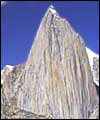|
|
| |||||||||||||||||
|
Karakoram Trifecta 25 SEP 2000
Most expeditions to the granite spires of the Karakoram are lucky if they can tag one summit. Perhaps two, if conditions are really good. Three? Including two first ascents? You'd probably get great odds against that in Vegas, assuming Sin City ever starts betting on climbing expeditions.
If it does, don't bet against Jonathan Copp and Michael Pennings. Fast, light and free is the mantra for the duo, who currently reside in Colorado and California, respectively. They set their sights on the unclimbed 18,000-foot-plus towers of Haina Brakk East and Cat's Ear Spire, and a repeat of Inshallah (Grade VII, 5.12 A1), a route on the 19,700-foot Shipton Spire, put up by Steph Davis, Kennan Harvey and Seth Shaw in 1998.
Upon their arrival on the upper end of the Trango Glacier, Pennings and Copp knew they had a lot to accomplish. "It was pretty unreal," says Copp, "We got there and we looked at these things and were, like, 'Wow, these are some amazing formations and if we can do one of them, we're super psyched.'"
First item on the agenda was Cat's Ear Spire. On their first attempt, they made it 1600' up, but were forced down by a storm. On their second attempt, they reached their highpoint and bivied. Another storm prevented climbing the next day, but on the following day, they gunned for the summit.
"We went with just Gore-Tex and a couple liters of water," says Copp, "and did a 24-hour push to the top and got to the summit at sunset. It was a crazy summit. Tiny — about the size of a tabletop — and just dropping on both sides." As the two did not bring a bolt kit and the summit offered no natural rappel anchors, both climbers had to lead and downclimb the final pitch, a slabby 5.9 arete protected by only a cam. The 23-pitch route went at Grade VI, 5.11d A1.
Next up was Haina Brakk East* tower, which had previously been attempted by a Hungarian party in 1997, who only made about halfway up the wall. Already on the southwest face of the tower were Americans, and married couples, Steve Schneider and Heather Baer, and Brian McCray and Roxanna Brock. Pennings and Copp chose a line on the east face and started up several days after the other party.
Climbing in the same speed mode as on Cat's Ear, the duo made swift work of the route, mostly freeclimbing it, with some aid. "We had a couple of pitches of aid and a really nutty tension traverse," says Copp. The traverse was a key point in the route, as it connected to a crack system that went free. They bivouacked twice and summitted on the third day, only one day behind the first American team.
"We summitted at mid day," says Copp, "and it was a glorious, perfect day, really warm up there." They named the route "Tague it to the Top" (Grade VI, 5.11 C2) to honor the memory of their close friend Cameron Tague, who died in a fall from the Diamond of Long's Peak earlier this year. After the summit, they rappelled down to their first bivy and finished the descent the next day.
Next up was Inshallah on Shipton Spire and, once again, they put their speedy freeclimbing skills to good use. They made two bivies on the wall and summitted at sunset on the third day, after an all-out 24-hour push. "Shipton ended up being really good," says Copp, "and it's a LONG route." After topping out, the team rappelled down to their first bivy and finished the descent the next morning.
Overall, Pennings and Copp displayed strong commitment to their chosen style and placed no bolts. "We eschewed the use of a hammer, placing a total of five pitons during the trip," says Copp, "four of which we took home. Part of our ethics include keeping the mountain like we found it." Instead of a portaledge, the duo relied on finding natural ledges. "On all the routes, we brought one sleeping bag and one Bibler tent," says Copp, "We'd just pull it over us if we couldn't set it up." It was this kind of commitment to light-and-fast climbing, with an emphasis on freeclimbing, that enabled them to pull off three successful ascents.
*Haina Brakk East: The tower we now know as Shipton Spire — so named by Greg Collum — was previously known in European texts and maps as Hainablak, which led its neighboring tower be dubbed Hainablak East. According to Central Asia Institute director Greg Mortenson, Mr. Husseinabadi, a noted Balti linguist, has determined the true name to be Haina Brakk (phonetically "aa-ee-na brok"), meaning "Glass Mountain." It is likely that the name Shipton Spire will continue to be used in Western climbing literature, but the name used for the neighboring spire can at least be revised.
— Matt Stanley, MountainZone.com staff
SEE ALSO: Forbidden Towers | Great Trango '99
|
|
||||||||||||||||


